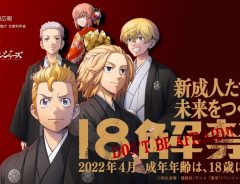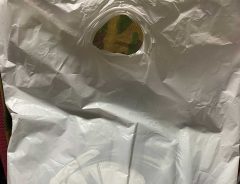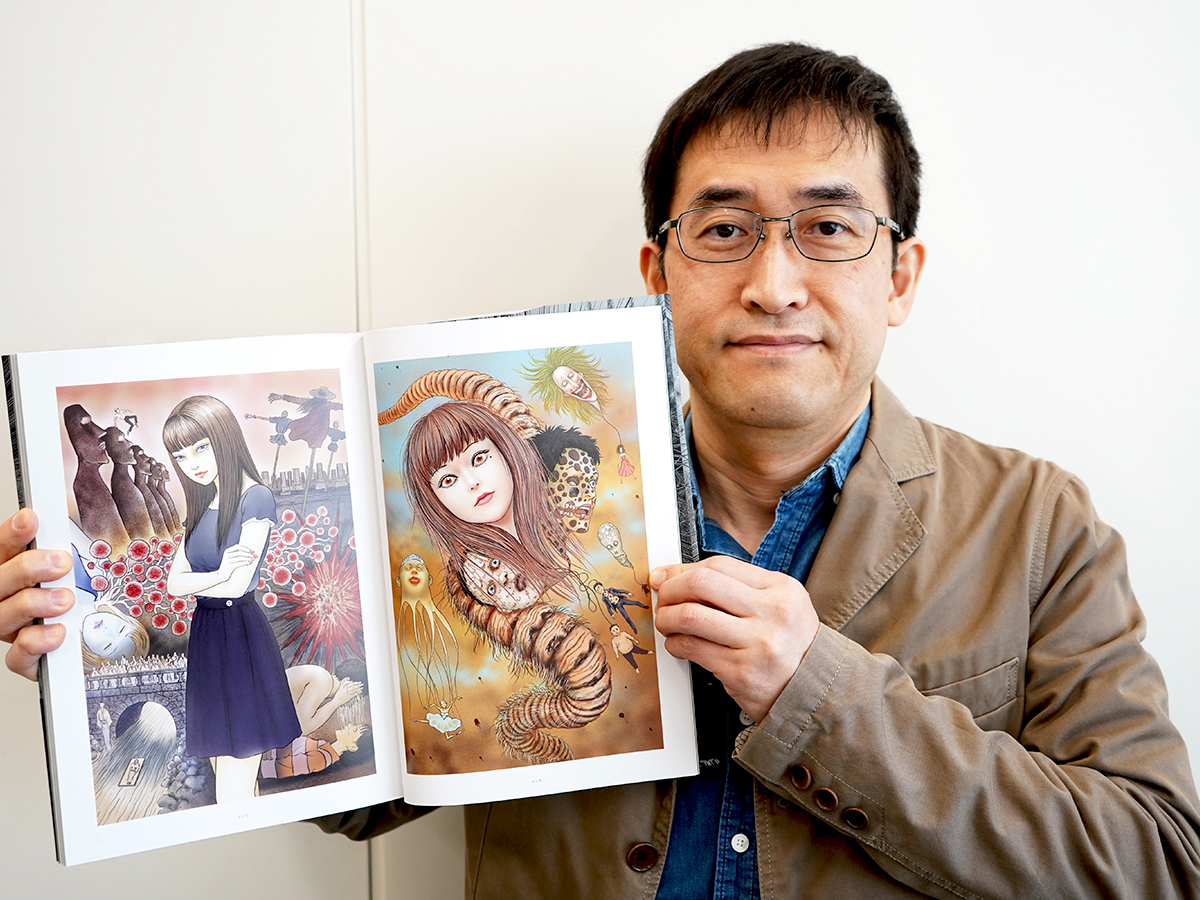- Tags:
- Asahi Shimbun / Asahi Shimbun Publications / Horror / horror manga / Igyo Sekai / Illustrations / Junji Ito / Manga
Related Article
-

Friends from ‘Tokyo Revengers’ manga fully inform Japan’s new adults
-

We sunk our teeth into the new SPY x FAMILY peanut butter burgers at Burger King Japan
-

Japanese man gets sus looks in the train but he understands why when he comes home
-

Kodansha Manga Award winner “Blue Lock” event at Fuji-Q Highland amusement park!
-

Manga artist was harassed for eating alone at ramen shops until she found a safe haven
-

On-Set Photos Of The Live Action Bleach Film Have Surfaced



Acclaimed manga artist Junji Ito has carved out a place for himself in the hearts of horror fans both at home and abroad, based not only on the merits of his manga but also because his works, such as "Uzumaki" and "Tomie," have inspired live-action films and anime (Junji Ito Collection) and have been translated into English as well as other languages.
As we reported earlier this year, Junji Ito is now celebrating 30 years since he made his debut with his first-ever published collection of illustrations in a handsome volume called Igyō Sekai 異形世界 (Grotesque World).
We had the fortunate opportunity to interview Junji Ito and his editor-in-charge, Makiko Hara, at the offices of Asahi Shimbun Publications which published the art book.
(Note: This is the full-length version of the abridged interview which we published last week)
Photo by © grape Japan
Interviewers: Ben K (grape Japan), Nobushi (Japanese-language media Grape).
The roots of horror: childhood experiences
Ben K: Since when have you been interested in horror as a genre?
Junji Ito (Ito): When I was very small, maybe 4 or 5 years old, my two older sisters would read Kazuo Umezu and Shinichi Koga in magazines and I read them too. That was my first experience. I was hooked. I began reading horror manga after that.
Ben K: Did you also watch horror movies?
Ito: Yes, when I was very young, I watched Dracula or Frankenstein when they showed it on TV. I lived in the countryside where there were no movie theaters nearby, so I could only see movies on TV. In the 70s, when the occult boom began, I saw The Exorcist on TV as well. So, I watched many occult films, like Dario Argento's Suspiria, for example.
Ben K: So, when did you begin drawing manga?
Ito: I was about 4 or 5 when I began reading, and very soon afterwards, I wanted to try it for myself. I took a pencil and paper, or sometimes the back of advertisements, and would draw frames, imitating the manga I had read. So, I started before I even entered elementary school. It was just for fun, of course. That was how I began.
Photo by © grape Japan
Nobushi: I was wondering about something. You say you began reading horror manga at 4 or 5. Kids that age scare very easily. But you were fine with it?
Ito: Yes. The manga I was reading wasn't that scary. On the other hand, TV shows where they went into haunted houses or had a medium who could summon spirits, I thought those were scary. Interesting, but scary. I couldn't go to the bathroom by myself. Especially since the bathroom in my house was at the end of an underground tunnel. When they showed photos with ghostly apparitions on those shows, that was scary. I was scared by things that seemed real to me. As for manga, of course, some of it was scary but for the most part, I found it interesting and intriguing. I loved Kazuo Umezu's drawings. Strange creatures, the grotesque. They fascinated me, so I enjoyed reading his manga. But that bathroom was scary...
Ben K: And if you had to go underground, there must have been insects, like centipedes and the like?
Ito: That's right. In my house, when you went down into the tunnel, we had a storage shed there with an earthen floor. Today, the foundation would be concrete but, in those days, it was exposed earth. And spider crickets would often be there. They look like crickets. We used to call them toilet crickets because they often showed up in those countryside toilets. They have spotted bodies, rounded backs and very long legs, with which they would jump all over the place as soon as you got near them. They really frightened me.
Photo by © grape Japan
Ben K: I can imagine. So, such experiences were later reflected in your manga.
Ito: They were indeed.
Nobushi: Would you say that most of your works are based on experiences you had and information you learned in your childhood?
Ito: Yes. For example, "The Hanging Balloons" was based on a childhood dream.
Nobushi: That dream must have really left an impression on you...
Ito: Yes. The impressions you have as a child are very strong and stay with you for the rest of your life.
Ben K: Was there a specific experience you had with balloons?
Ito: I lived in the countryside, but I occasionally went into town. I would see ad balloons floating above the buildings, and they were symbols of life in the big city which I aspired to. Also, I liked flying saucers as a kid, UFOs. Strange, unidentified, mysterious objects in the sky. So, I combined elements which I liked and incorporated them into my work.
Dental technician and manga artist
Ben K: Jumping forward a bit, you went to a vocational school and became a dental technician, correct?
Ito: Correct.
Ben K: And you were active as a manga artist while you were working as a dental technician?
Ito: Yes, I began working as a dental technician in around 1984, and then I began working on manga, so I was doing both for about three years...
Ben K: So then, did your experience as a dental technician have any influence in the world you depicted in your manga?
Ito: Well, since it was a medical school, I learned names of body parts in Latin and learned some basic anatomy. Beyond that, however, I learned not through school textbooks but rather illustrated anatomy books for medical students which I bought for myself at bookstores. I don't remember exactly how it was, but I do remember looking at those pictures to draw muscles, for example.
Ben K: And then in the story "Black Paradox," you talk about the pylorus.
Ito: The pylorus, right. In Japanese, it's written yūmon 幽門, which has the kanji for ghost in it, which I liked, but there's no deeper meaning beyond that.
Ben K: Yes, but isn't it because you studied such words in vocational school that you had the idea?
Ito: Ah, yes, you could say that.
Ben K: And then there's "Frankenstein," which came up later in your work...
Ito: Yes, there's a scene where body parts are attached together, so I think my experience was somewhat useful there. But what {my dental technician experience} really helped me the most was for the pens I use to draw manga, the tools of the trade. I learned techniques I could use to customize those tools, such as cutting and whittling down pens to make them shorter, cutting grooves into the base so they would be easier to hold, sanding them down to make them smooth and clean. That all came from the techniques I learned to shape and finish dentures.
On Tomie
Ben K: I’d like to ask you about your works now. One of your most famous series, as well as your debut work is “Tomie.” Was there any inspiration for Tomie in real life, a model, for example?
Photo by © grape Japan
Ito: No, I’m afraid there wasn’t a beautiful woman who was the model. When I was in junior high school, a boy in my class died in a traffic accident. It just felt so odd to me that a classmate who was so full of life should suddenly disappear from the world, and I had the strange feeling that he would show up again innocently. Ever since then, I wanted to give expression to that feeling in my manga. That’s how I came up with the idea of a girl who is supposed to have died but then just shows up as if nothing had happened. In real life, it was a boy who died, but I turned her into a girl in the manga.
Ben K: I see. "Tomie" was first serialized in a girl's magazine called Gekkan Halloween 月刊ハロウィン (Monthly Halloween). She manipulates men, drives them crazy, yet comes back to life again and again no matter how many times she is hacked into pieces or killed in any number of violent ways. Why do you think such a character was so popular with the primary audience of girls who read "Tomie" in Gekkan Halloween?
Ito: Well, immortality, never dying, is something I think everyone longs for. At some point, we all wish we could be immortal. But Tomie lives her life completely as she wishes. She's haughty yet she captivates men. I imagine women have this desire to act like a princess. They envy Tomie's freedom, that's what I think...
Ben K: Was there anything confirming that in the fan letters your readers sent?
Ito: Yes, there was. Some girls even wrote that they were aspiring to become Tomie (laughs).
Photo by © grape Japan
On "Gyo"
Ben K: Now, I'd like to ask you about "Gyo." Ultimately, the creatures seem to take over Japan and I feel it's implied that they will eventually take over the world. But in the beginning, they were born out of chemical weapons experiments. Considering these origins, was there an anti-war message in depicting monsters like this?
Ito: When I was a child, my parents, who were of the war generation, would tell me tragic and frightening war stories, so I naturally developed a strong awareness of war as a scary thing. What's more, as a boy, I was afraid I would be drafted as a soldier when I grew up. This fear of mine naturally developed into anti-war feelings, and I think this is reflected in my work.
Ben K: "Gyo" is quite a remarkable work with many fans. The fusion of organic and inorganic, and an uncanny sense of agency as well...
Ito: I wanted to tell the story so that the mastermind behind the phenomenon would remain a mystery... It was quite a while ago, so I can't remember it too well now, but one of the characters gives it away at the end. If I had extended the story, I would have been able to flesh it out further... but I exhausted my energy on it.
Photo by © grape Japan
Personal favorites
Ben K: Looking at your body of work so far, do you have any personal favorites?
Ito: "Long Dream," "The Hanging Balloons" and " The Enigma of Amigara Fault." I would say those are my favorites. I don't think I'm very good at long stories, so I don't have any which I'm personally satisfied with. Short stories are easier to write well, and I’m happy with those three.
Ben K: I personally liked "Long Dream." It has a strong science fiction element to it. Were you inspired by any specific work of science fiction?
Ito: When I was a kid, my eldest sister told me something she had learned. She said that dreams are viewed in an instant. You see, when you're sleeping and have a dream, you feel time passing by, but for someone looking at the dreamer objectively, the dream only takes an instant. I did some research online recently, and it seems that this used to be a major theory. I think they called it the "instantaneous generation" theory. I was fascinated with this notion. I imagined that if you could have a dream that lasted for a considerable duration, it might be possible to have a very long dream in an instant as well. At first, I thought I could make it a science fiction story. I used to love science fiction in middle school, and I created short-short stories under my name. But I only got through the beginning before I stopped (laughs). It was an interesting topic, however, so I came back to it, this time as horror. That's how the story came to be.
Fascination with the grotesque
Nobushi: I have a question I'd personally like to ask you, if I may. What is it about the grotesque that appeals to you?
Ito: What is it, indeed. I'm not too sure of the reason. It could be that my curiosity is stronger than fear or perhaps I just have bad taste. Something which is a bit different from human, not animal either and yet exists in our world. It spreads in rumors and remains a mystery. In the past, rumors about such things as kuchisake onna 口裂け女 {an urban myth about a woman with a split mouth who kills passersby} were common. With things like that, rumors spread first before facts. It's thrilling. So, for me, rather than scary, those things were thrilling and fascinated me.
Nobushi: It's the mystery of it that you found interesting?
Ito: That, and the fact that these are products of our imagination. I find it interesting that humans have such powers of imagination. Demons, for example, may have had a model inspiring them, but yōkai 妖怪 {Japanese monsters} come in so many varieties, and their forms can be very interesting. It is said that yōkai are inspired by particular human characteristics which are then exaggerated. There's something fun in peeking into a world which exists outside of our everyday experience.
On the anime series Junji Ito Collection
Ben K: I understand. I'd like to change topics now to the anime series Ito Junji Collection. What is your impression of how it turned out?
Ito: Shinobu Tagashira was the director. She really likes my work and respects it. In the way she expressed the mood of the manga, told the stories, and showed the images, I got the impression that she took great care in handling my work. I think some episodes turned out even better than the original.
Ben K: For example...?
Ito: Well, there's a story called: "Lingering Farewell." It's a tear-jerker, but the way she did it, you'll cry even more than the manga. The music was wonderful, too. Also, I think she did a fantastic job with the Sōichi series...
Ben K: From the beginning, I agree.
Ito: And the voice actor for Sōichi was superb.
Ben K: Yes, I was about to say that he really sounded like Sōichi should.
Ito: (Laughs) Yūji Mitsuya. He's a veteran voice actor whose work I've been familiar with for many years...
Nobushi: Did you have a say in the process? I mean, in deciding which voice actor should handle which character?
Ito: For "Tomie," we had an audition, and I was there for several candidates. At the end, we narrowed them down and I made the final decision. I thought she had class. Tomie's language is a little bit old-fashioned, and this voice actress spoke Tomie’s lines with an intonation reminiscent of the Showa Era. So, I felt that she might be a good choice.
On Junji Ito's first artbook, Igyō Sekai (Grotesque World)
Photo by © grape Japan
Ben K: I see. Thank you. Now, I'd like to ask you about this beautiful art book. This is your first one. Was there a reason behind the timing of its publication?
Ito: 30 years have passed since I began creating manga, so this book was produced as a 30th year commemorative project. Hara-san was in the charge of everything...
Hara: Yes, it was a 30th year commemoration, but there's more to it. Mr. Ito's works have been translated a lot outside of Japan. So, in addition to commemorating Mr. Ito's 30th year, I also had foreign language translation in mind when I planned the book.
Ben K: So then, you already have plans for translated version?
Hara: We do. Although I cannot disclose any details at this time, we are already in talks with several countries with regards to translations.
Ben K: Judging from the reaction within English-language fan communities when the art book was announced, demand for a translation is high! I'm sure fans would love it.
Ito: There's an afterword, an explanation part at the end of the book where I talk about how I created each work in an interview format. I would be happy to see that translated.
Hara: At the exhibition commemorating the book which we held from March to April, there were many foreigners buying the art book.
Photo by © grape Japan
Ben K: Speaking of the art images, did you have criteria in selecting which ones to include?
Hara: At first, I thought I'd like to include everything if I could. But I learned very early on that it was impossible to include everything (laughs). Some of Mr. Ito's works are no longer in his possession and I realized early on that we couldn't obtain them. So, we changed the concept to collecting all originals, pieces which weren't based on works by other authors. That's why we didn't include "No Longer Human" or "Rasputin the Patriot." So, that was our criteria: original-only pieces, and as broad a selection as possible. Also, from the beginning, Mr. Ito and I wanted the book to properly convey the appeal of black and white prints, so we also accentuated that.
Ben K: It's truly a wonderful book and I'm thoroughly enjoying the copy I bought...
Future plans
Now, I'd like to ask you a different question. Going forward, is there a kind of manga you'd like to create, or, not limited to manga, something new you'd like to try?
Ito: Well, when it comes to manga, I don't have long-term aspirations about some grand scale project I'd like to create. I'm more about devoting all my energy to the work that's in front of me. What kind of manga I'd like to create...? If I had to say something, I would like to create more short works I can be satisfied with. As for non-manga projects, for this art book here [points to the book], the cover is an original I drew. I'd like to draw more single works like that. I think drawing such works, illustrations, is fun. Recently, I've been mostly working with digital tools, but doing things the analog way, drawing on paper like old times is enjoyable for me, so I'd like to do more of these single image works.
Ben K: So, does that mean we will be seeing more exhibitions in the future?
Hara: Yes. In addition to art galleries in Tokyo where Mr. Ito's works are occasionally exhibited, he also makes international appearances. For example, at the end of August in San Jose, Mr. Ito is invited to the Crunchyroll Expo, where there will be a gallery of original works, and goods will be sold. Mr. Ito will also bring original drawings from his manga, and those will also be displayed.
Ben K: I'm sure fans will be pleased... Mr. Ito, your works have been adapted to live action film before by Japanese directors. If you were able to work with a foreign film director on a future project, do you have any names that come to mind?
Ito: Hmm... This director was active in the 1970s. He's quite advanced in age now. Dario Argento, an Italian director famous for "Suspiria." I think he would film women very beautifully. Of course, this is just my own personal wish (laughs). Also, William Friedkin, director of "The Exorcist" series... He's also quite advanced in age... I don't know young directors very well.
An interest in VR
Ben K: Your manga has been adapted into anime and live action films. Do you have an interest in games?
Ito: (laughs) I really don't know much about games. My nephew plays and sometimes I play with him but I'm just not good at it. But I am interested in VR. Holding a control pad with your hands doesn't feel intuitive to me, so I'm not good at it, but if you could play by experiencing something the way you know it from reality, for example flying in a plane... That would be fun to try in VR.
Ben K: For example, can you imagine one of your works adapted to VR? Something you can experience.
Ito: Experience? Let's see, maybe being chased by monsters.
Hara: How about “The Hanging Balloons”?
Nobushi: In 360 degrees.
Ben K: The game would be you have to escape from the hanging balloons (laughs).
Ito: I like that (laughs). The player would wear a collar which would tighten a bit when you get caught (laughs).
Ben K: You mean it would have a sensor attached?
Ito: Yes, right. (laughs)
Photo by © grape Japan
What is Junji Ito afraid of
Ben K: This will be my last question. What is it that truly frightens you in real life?
Ito: I talked about it before, but it's war. I know it's not an exciting reply but, in the end, it all boils down to a fear of death. Also, mysteries which hint at death, situations where I fear there is impending danger, where something unknown lurks ahead, things that heighten my insecurity. And then, the cricket spiders I talked about earlier, or centipedes, millipedes and cockroaches. They frighten me, too.
Ben K: I see. That's why they show up in your works...
Ito: Yes, I make it a point to put them in (laughs).
Nobushi: So, you get shivers at your own works?
Ito: I do. For example, I have a manga about a man with a severed neck. There's a scene where a cockroach is inserted in the cut... That was awful (laughs).
Ben K: It gave me the shivers.
Ben K: Could you please sign my book?
Ito: Oh, sure...
Photo by © grape Japan
Ben K: Thank you very much for your time.
Ito: Thank you...
Photo by © grape Japan